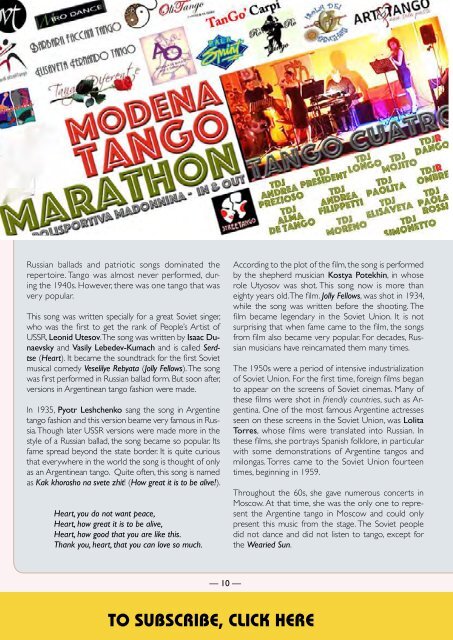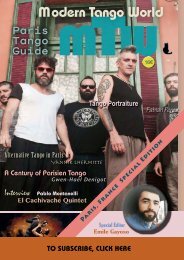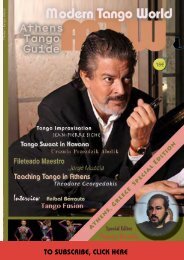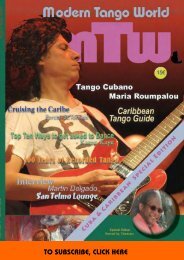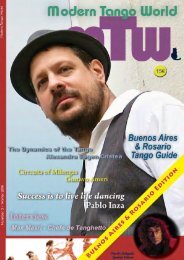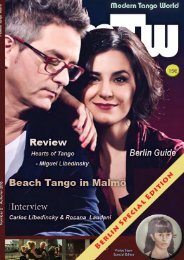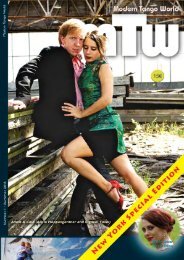Modern Tango World #8 (Moscow)
Moscow Special Features Magnolias on the Snow Andrey Klimovich 03 Milonga Chique Evgeny Morozow 10 The New Moscow Polina Yegurnova 14 Guide to Tango in Moscow 18 Sunset Tango Collages Denise Mumm 22 Interview with Jonathan Goldman Marco Buso 26 The Other Night at La Viruta Daniel Pereyra 31 Book Review: Tango Awareness Alexandru Eugen Cristea 34 Why There is so Little Dance in Dancing Tango Veronica Toumanova 35 New Tango Music Arndt Büssing 38 Tango Moves: Boleos (Voleos) Raymond Lauzzana 42 Letters to the Editor 46
Moscow Special Features
Magnolias on the Snow Andrey Klimovich 03
Milonga Chique Evgeny Morozow 10
The New Moscow Polina Yegurnova 14
Guide to Tango in Moscow 18
Sunset Tango Collages Denise Mumm 22
Interview with Jonathan Goldman Marco Buso 26
The Other Night at La Viruta Daniel Pereyra 31
Book Review: Tango Awareness Alexandru Eugen Cristea 34
Why There is so Little Dance in Dancing Tango Veronica Toumanova 35
New Tango Music Arndt Büssing 38
Tango Moves: Boleos (Voleos) Raymond Lauzzana 42
Letters to the Editor 46
You also want an ePaper? Increase the reach of your titles
YUMPU automatically turns print PDFs into web optimized ePapers that Google loves.
Russian ballads and patriotic songs dominated the<br />
repertoire. <strong>Tango</strong> was almost never performed, during<br />
the 1940s. However, there was one tango that was<br />
very popular.<br />
This song was written specially for a great Soviet singer,<br />
who was the first to get the rank of People’s Artist of<br />
USSR, Leonid Utesov. The song was written by Isaac Dunaevsky<br />
and Vasily Lebedev-Kumach and is called Serdtse<br />
(Heart). It became the soundtrack for the first Soviet<br />
musical comedy Veselilye Rebyata (Jolly Fellows). The song<br />
was first performed in Russian ballad form. But soon after,<br />
versions in Argentinean tango fashion were made.<br />
In 1935, Pyotr Leshchenko sang the song in Argentine<br />
tango fashion and this version beame very famous in Russia.<br />
Though later USSR versions were made more in the<br />
style of a Russian ballad, the song became so popular. Its<br />
fame spread beyond the state border. It is quite curious<br />
that everywhere in the world the song is thought of only<br />
as an Argentinean tango. Quite often, this song is named<br />
as Kak khorosho na svete zhit! (How great it is to be alive!).<br />
Heart, you do not want peace,<br />
Heart, how great it is to be alive,<br />
Heart, how good that you are like this.<br />
Thank you, heart, that you can love so much.<br />
According to the plot of the film, the song is performed<br />
by the shepherd musician Kostya Potekhin, in whose<br />
role Utyosov was shot. This song now is more than<br />
eighty years old. The film. Jolly Fellows, was shot in 1934,<br />
while the song was written before the shooting. The<br />
film became legendary in the Soviet Union. It is not<br />
surprising that when fame came to the film, the songs<br />
from film also became very popular. For decades, Russian<br />
musicians have reincarnated them many times.<br />
The 1950s were a period of intensive industrialization<br />
of Soviet Union. For the first time, foreign films began<br />
to appear on the screens of Soviet cinemas. Many of<br />
these films were shot in friendly countries, such as Argentina.<br />
One of the most famous Argentine actresses<br />
seen on these screens in the Soviet Union, was Lolita<br />
Torres, whose films were translated into Russian. In<br />
these films, she portrays Spanish folklore, in particular<br />
with some demonstrations of Argentine tangos and<br />
milongas. Torres came to the Soviet Union fourteen<br />
times, beginning in 1959.<br />
Throughout the 60s, she gave numerous concerts in<br />
<strong>Moscow</strong>. At that time, she was the only one to represent<br />
the Argentine tango in <strong>Moscow</strong> and could only<br />
present this music from the stage. The Soviet people<br />
did not dance and did not listen to tango, except for<br />
the Wearied Sun.<br />
— 10 —<br />
TO SUBSCRIBE, CLICK HERE


